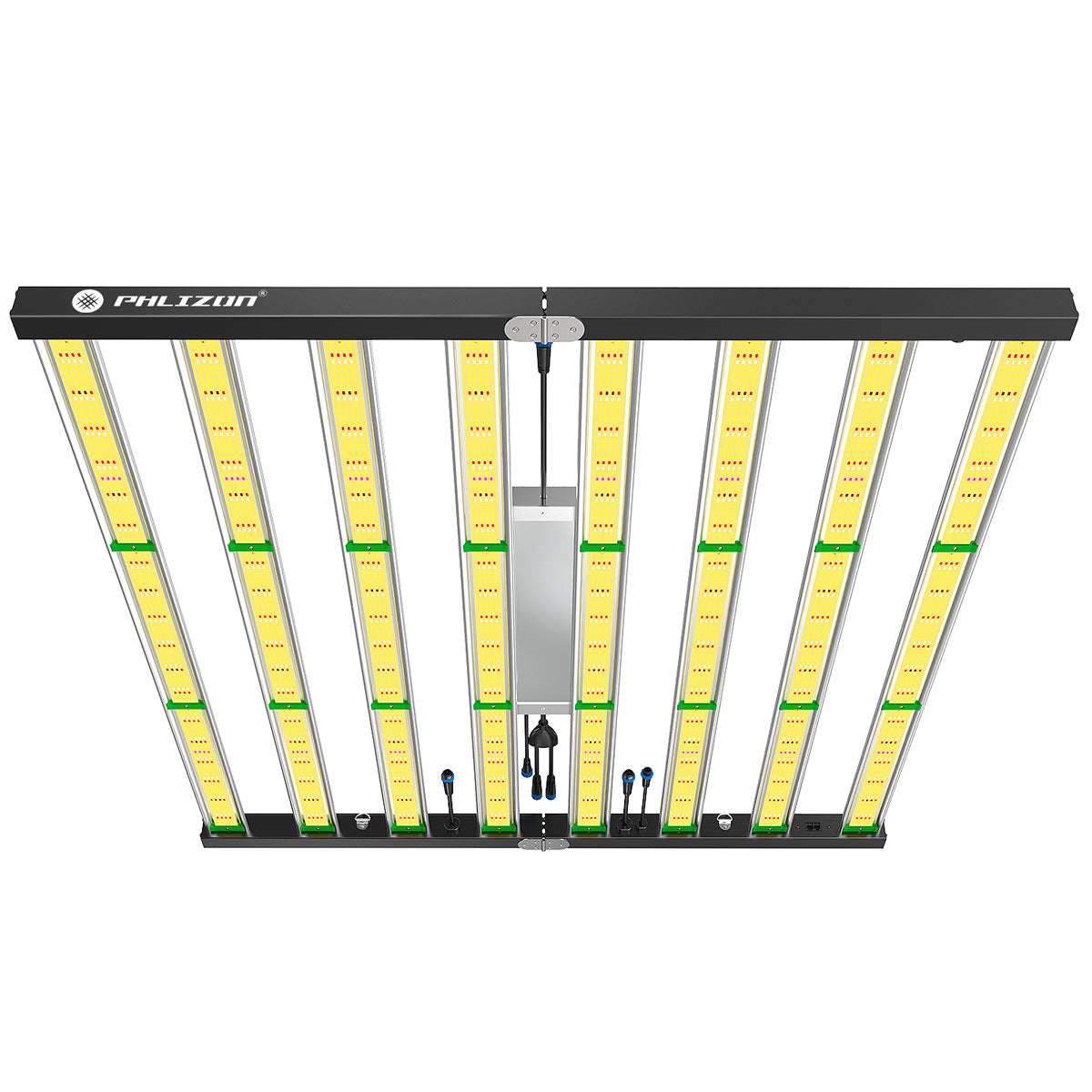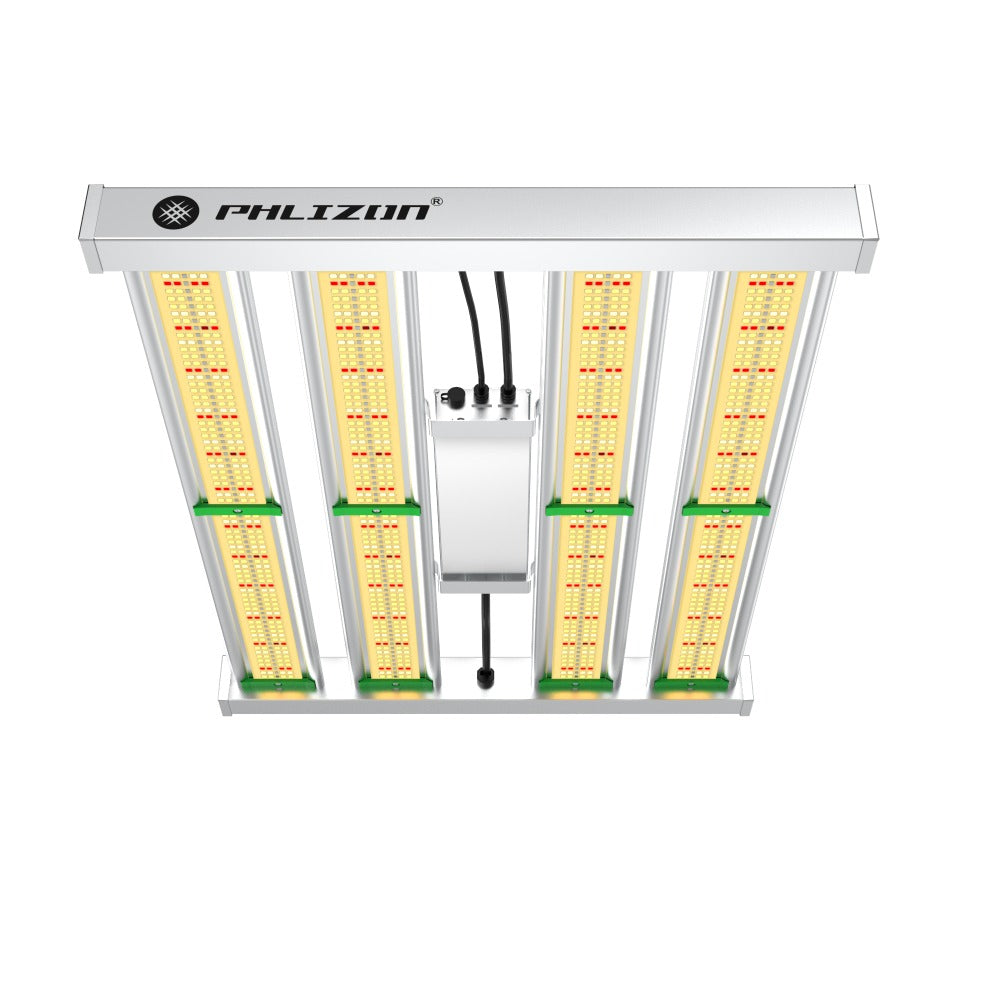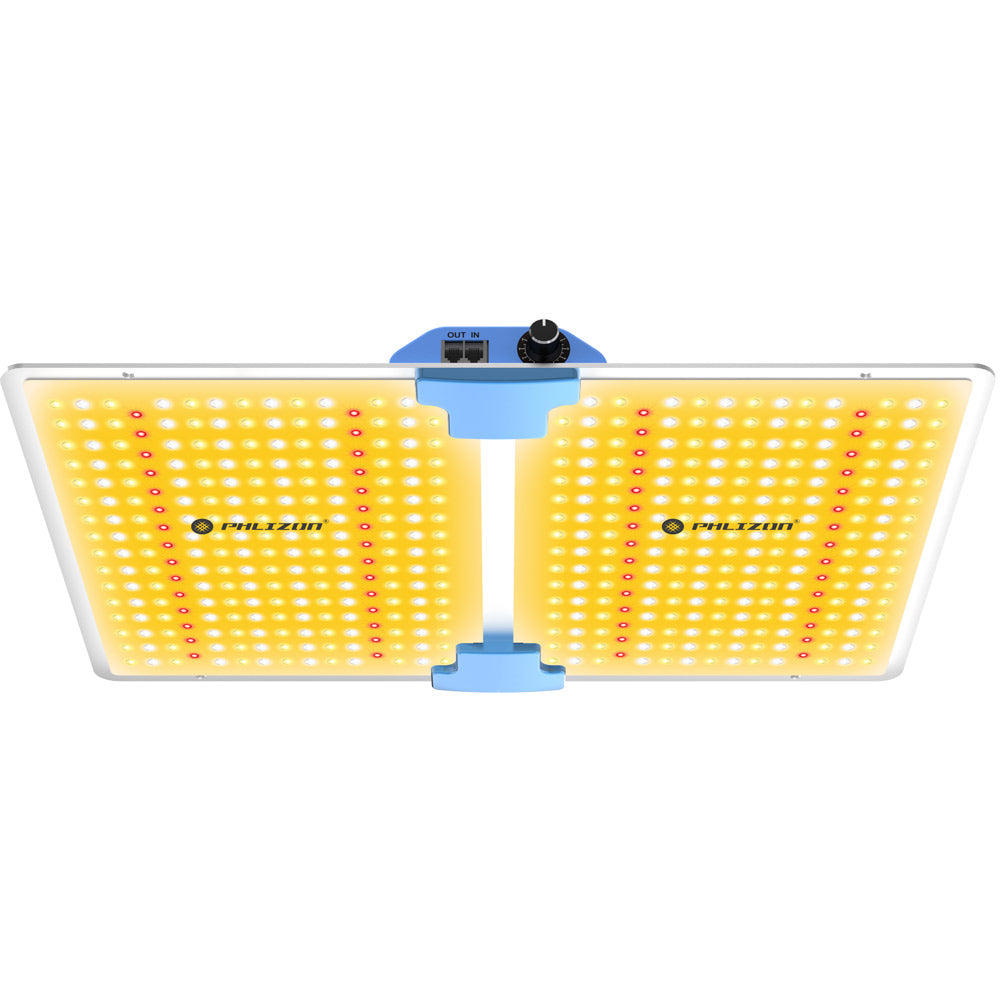Menu
UV and IR Light for Your Plants
Plants rely on light to grow, but not all light is the same. While visible light, particularly red and blue wavelengths, drives photosynthesis, ultraviolet (UV) and infrared (IR) light play unique roles in plant development. These invisible spectra, often overlooked, can enhance growth, boost quality, and mimic natural conditions indoors. This article explores how UV and IR light affect plants, their benefits, risks, and practical applications for growers.
What Are UV and IR Light?
Ultraviolet light and Infrared light both belong to the “Electromagnetic spectrum”. Radiation in the Electromagnetic spectrum is usually categorized by wavelength. Ultraviolet, Gamma, and X-rays are examples of short wavelengths while Infrared, Radio, and Microwaves are examples of longer wavelengths. Short wavelength radiation is of the highest energy and can be very dangerous. Infrared is usually less harmful. Both UV and IR lights can be used to help plants grow more effectively.
UV light, or ultraviolet light, is a form of electromagnetic radiation with wavelengths shorter than visible light but longer than X-rays. It is named ‘ultraviolet’ because it starts from the wavelengths just beyond the violet end of the visible light spectrum. The wavelengths of UV light range approximately between 10 and 400 nanometers (nm). UV light can be categorized into three main types based on wavelength: UVA (315-400 nm), UVB (280-315 nm), and UVC (100-280 nm). UVA makes up the majority of the UV light reaching the Earth's surface. UVB has a medium wavelength, but it is powerful. Since UVB is energetic, it has an antimicrobial effect on growing plants. UVC has the shortest wavelength, and it is almost absorbed by the atmosphere.
Infrared (IR) light is a type of electromagnetic radiation that has a longer wavelength than visible light (more than 700nm), and is not visible to the human eye. IR radiation is divided into three main subtypes based on their wavelength: near-infrared (NIR, 700–1100 nm), mid-infrared (MIR), and far-infrared (FIR, >1100 nm). NIR radiation has the shortest wavelength and is closest in wavelength to visible light, while MIR and FIR have longer wavelengths and are often used in heating applications. Nearly half of the light that reaches the surface of the earth is what we call infrared light.
Do Plants Need UV and IR Light?
The short answer is that plants do not necessarily need UV light to grow. What they need most during the plant life cycle is red and blue light. However, gardeners who implement UV lights for plants, particularly UVA and UVB light, are more likely to have robust stems, healthy foliage, and quality yields. Plants grown indoors without exposure to UV can lack these enhanced benefits. That’s why it is so important to choose indoor grow lighting that includes photons in the UV range.
No, plants do not need IR light to grow. IR light doesn’t work as a fundamental lighting source for growing plants, but it does have its value: IR light can penetrate deeper into plant tissues, promoting stem growth and flowering. Additionally, IR light, when combined with far-red light, can trigger a shade avoidance response, accelerating stem growth. Proper use of IR light can quickly induce plants to enter the flowering stage or transition into a dormant phase. While IR light offers numerous benefits, a large portion of IR light manifests as heat. Overexposure can lead to overheating, causing stress, dehydration, and even plant death.
Benefits of UV Light for Plants
UV light is effective at recreating a natural environment and therefore making plants act like they are being grown in the wild. The UV light for plants has been known to promote faster photosynthesis, increase leaf areas, increase THC and CBD potency, promote branching, and provide higher resistance to pests. Proper use of UV lights for plants can also improve plants’ nutritional quality while stimulating biomass production by stressing them.
- Morphological Development: Exposure to UVA light influences the morphology of plants, resulting in compact and sturdy growth, essential for crops and ornamental plants.
- Flavor and Color Enhancement: UVA light enhances the production of pigments, flavonoids, and antioxidants, improving the color, flavor, and nutritional value of plants.
- Pest Control: UVA serves as a natural deterrent to certain pests, reducing the dependency on chemical pesticides.
- Faster Photosynthesis: Studies have shown that exposure to UVA light can speed up the process of photosynthesis by around 12%, leading to increased growth, leaf size, and dry weight.
UV light can also promote faster germination when starting seeds. They strengthen the plant and prepare it for higher light intensities. It reduces the “shock” time of the seedlings while also speeding up germination. Some studies have shown that UVA and UVB light can enhance the production of terpenes and flavonoids in plants. In one study, growers cultivated tomatoes in a greenhouse using grow lights without UV. They noticed the tomatoes grew great, but the taste left plenty to be desired. So, they grew another batch with supplemental UV and found that flavor and aroma were greatly amplified.
UV-B increases photosynthetic activity in many plant species. There is a guarantee for increased flavonoid production in the leaves of old and young plants. Also, UV-A radiation equally has a positive effect on plants’ photosynthetic activity when there is exposure to UV-B. Plants produce 15 different varieties of defense proteins when they are exposed to UV light. UV light destroys harmful microorganisms when the wavelengths are shorter than 300 nm. Besides, UV light increases your plants’ resistance to insects, bacteria, and fungus.
Benefits of IR Light for Plants
Infrared radiation possesses numerous benefits for plants such as adequate node spacing. IR light can heat the plant surface and subsequently increase leaf temperature. This can promote and increase plant growth. IR lights utilize far-red wavelengths to elicit a shade avoidance response in plants, leading to accelerated stem growth. There are two procedures known as PS1 and PS2 which contribute to plant growth. Plants exposed to supplemental IR light alongside both blue and red light showed an increase in photosynthesis, the promotion of robust stem growth, proper node spacing along with more flower buds. IR light also appears to help plants transition between different stages of growth, sleep and wake cycles, during the later stages of development.
Infrared light also has its benefits for plants. First, in smaller amounts, infrared lights are harmless to plants and their life cycle. Most times, when plants are grown in an area, what destroys the plant is excess exposure to the ever-available infrared light. Plants do better in adequate amounts of infrared exposure. Aside from growth, there are several other benefits conferred by infrared lights to plants. They include:
- Stem Growth and Flowering: IR light, particularly in the far-red wavelengths, can trigger the shade avoidance response, where plants sense a lack of direct light and accelerate stem growth to reach for better light conditions.
- Photosynthesis Boost: IR enhances the effectiveness of Photosystems I (PSI) and Photosystems II (PSII), which are key components of the photosynthesis process.
- Warmth: In contrast, IR light provides plants with the warmth they need for optimal growth, particularly in cooler climates. It indirectly enhances photosynthesis by maintaining an ideal temperature range and promoting leaf expansion and stem elongation.
Risks of UV and IR Light
While UV and IR lights are beneficial to plants’ growth, excessive exposure to ultraviolet (UV) and infrared (IR) light can also have negative effects on plants. Overexposure to UV light for plants can cause damage to plant cells, including the breaking down of chlorophyll, which is essential for photosynthesis. This can result in stunted growth, reduced yields, and even death of the plant. Prolonged exposure to UV light for plants can also cause leaves to become brittle and discolored. The overuse of UV lamps for plants can lead to light stress, which in turn can hinder plant growth and lower plant yields. This is due to plants spending more energy on producing trichomes as a way of protecting themselves, as opposed to growing larger and more robust. UV stress can also lead to photoinhibition of chloroplasts resulting in lower biomass production, photobleaching, and the death of leaves.
Similarly, excessive exposure to IR light can also be harmful to plants. While plants require some amount of IR light for optimal growth and development, excessive exposure can lead to heat stress and dehydration, which can cause the plant to wilt or die. In addition, IR light can also cause the leaves of some plants to become scorched or discolored, affecting their ability to perform photosynthesis. Too much IR radiation can cause plants to stretch spreading out the plant nodes, can discolor the leaves or even kill the plants.
How to Use UV and IR Light for Indoor Plants
The most efficient way to use supplemental UV and IR light depends on the specific plants you are growing and the size of your growing space. Different plants have varying requirements for light intensity, Photosynthetic Photon Flux Density (PPFD), UV, and IR exposure. Below is a general guide tailored for weed cultivation, which can be adapted for other crops with proper research.
During the vegetative stage, we recommend you provide your plants with between 16 to 18 hours of light per day to help ensure they grow to become healthy and high-yielding plants. In addition to the 16-18 hrs of main grow lights, introduce 1 hour of supplemental UV light for plants per day during the mid-to-late vegetative stage. This encourages robust plant development and prepares them for the flowering phase. Cannabis requires at least 16 hours of light at the vegetative stage. One hour of supplemental UV light every day is recommended in the mid-to-late vegetative stages. When it comes to the flowering stage, cannabis needs at least 12 hours of light. To increase THC content in the flowers, 90 to 120 minutes of supplemental UV light for this stage is recommended.
Infrared light can be used for seedling, vegetative, and flowering stages. Supplement infrared light for 30 minutes before you turn the lights off for the day to promote plant growth and flowering. During this fast-growing phase, we suggest you maintain light intensity between 400-600 µmol/m²/s. If you wish to increase the UV exposure time, we recommend gradually increasing it while continuously monitoring the plants' responses, as different plants react differently to UV. Ensure the UV output isn’t too high, as excessive UV can harm plants rather than benefit them. UV exposure is a stressor, and while controlled stress can boost yields and quality, too much stress can stunt growth.
Practical Tips for Growers
Choosing a light with the right appropriate amount of far-red and infrared light is key for healthy and natural plant growth. Platinum LED combines intense and efficient PAR output, with a targeted spectrum that include UVA and far-red/IR light. Platinum LEDs include UVA diodes in the 380nm spectral range that is known to promote robust yields for most plant types, and high terpene, THC, and CBD production for cannabis plants. It also provides far-red/IR in the 760 nm range that is ideal for robust stem growth, proper nodes spacing, more flowers and fruit.
For the best results, make sure you provide your plants a high-quality UV grow light. Many full-spectrum LEDs will emit just the right amount of each type of UV. It will mimic natural sunlight, too, so plants will feel as though they are being grown outdoors. There are even ceramic (CMH) grow lights that emit UV light, along with some double-ended (DE) bulbs. Before you go and buy an industrial UV lamp for your plants, understand that their requirements for UV light are super low. Less is more in this instance. You can get great results with just 2-3 watts of UV light per square foot of growing space. This means for a 4’x4′ tent, for example, you would be just fine with around 32-48 watts of UV lighting to yield the benefits.
FAQs About UV and IR Light for Plants
Q: Can I use UV and IR light together?
Yes, combining UV and IR light can mimic natural sunlight more closely, providing a balanced spectrum. UV enhances quality traits like flavor and pest resistance, while IR supports growth and flowering. Just ensure you monitor exposure to avoid stress or overheating.
Q: How long should I expose my plants to UV light?
It depends on the growth stage and plant type. For vegetative growth, 1-2 hours daily is often sufficient. During flowering, you might increase to 2-4 hours, especially for plants like cannabis, to boost resin production. Start low and adjust based on plant response.
Q: Is UV light safe for me when working in the grow room?
UV light can harm your skin and eyes, especially UVB and UVC. Wear protective eyewear and sleeves if you’re near active UV lights. Limit exposure by timing UV use when you’re not in the room.
Q: Does IR light replace heat lamps?
Not entirely. IR light provides warmth, which can help in cooler environments, but it’s primarily for growth stimulation. Heat lamps focus on temperature control, while IR in grow lights targets plant processes like stem elongation.
Q: Can too much UV or IR kill my plants?
Yes, overexposure is risky. Too much UV can burn leaves or stunt growth by damaging chlorophyll. Excessive IR can overheat plants, causing dehydration or wilting. Always start with low doses and observe your plants.
Q: Do all plants benefit from UV and IR?
Not equally. Some, like cannabis or tomatoes, thrive with UV for potency and flavor. Others, like delicate herbs, may not need much. IR benefits most plants by aiding growth, but research your specific crop’s needs.
Conclusion
UV and IR light aren’t essential for plant survival, but they offer significant advantages when used wisely. UV boosts photosynthesis, enhances flavors, and strengthens defenses, while IR promotes stem growth, flowering, and warmth. Together, they recreate the natural spectrum plants evolved under.
Featured blog
- Choosing a selection results in a full page refresh.

















